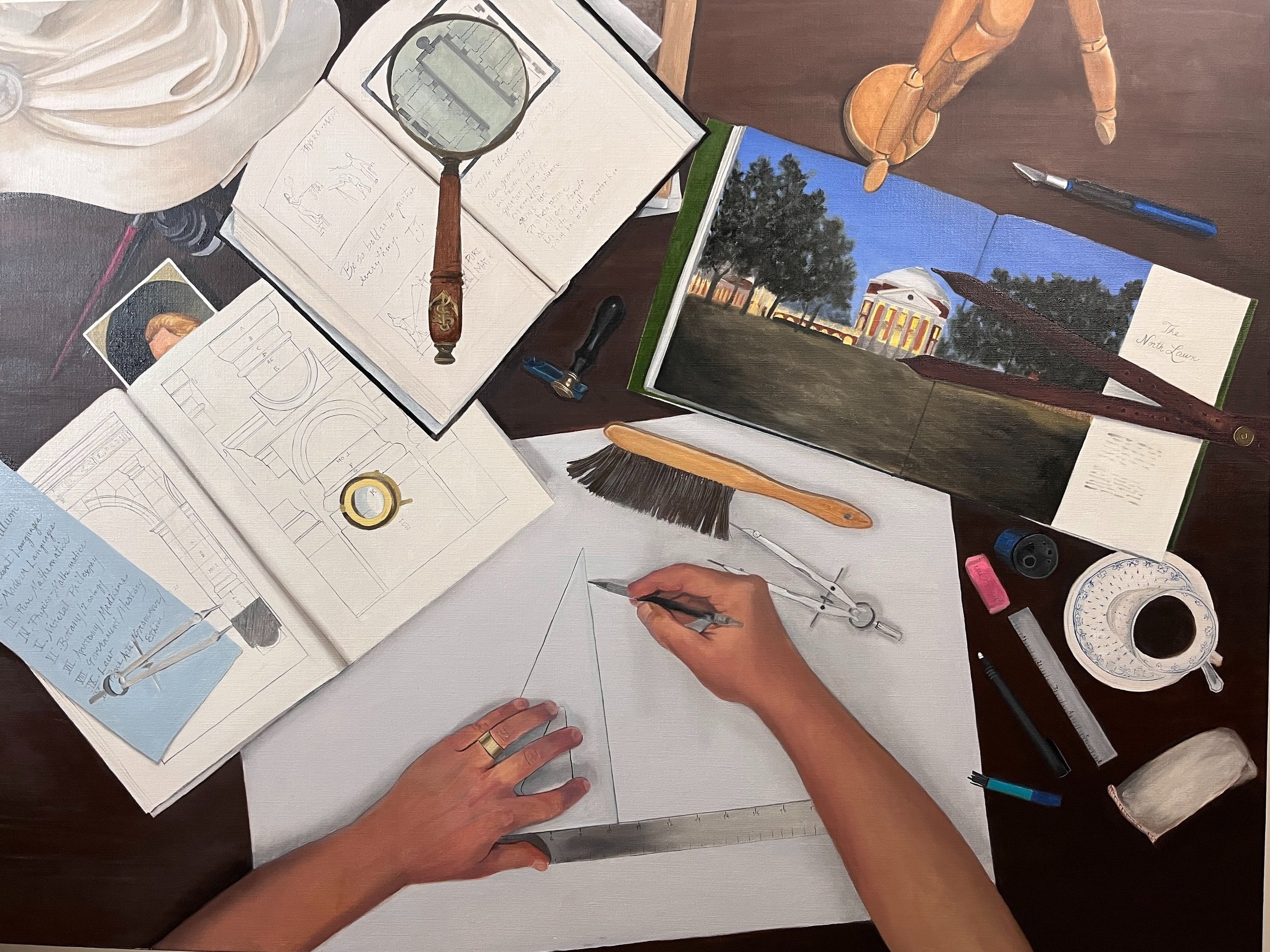
Curriculum Vitae
Phaeton Gallery, Charlottesville, VA, 2022
Twenty one years ago, when I was twenty one, I spent a summer in Charlottesville at the University of Virginia. I walked the grounds everyday absorbing all that I could about its founder Thomas Jefferson, his ideas about education, his American interpretations of Palladian architecture, and about the several, mysterious societies whose emblems were painted on the red brick sidewalks throughout. This carefree summer was my last as a college student, right before 9/11, and before I embarked on my professional career as a costume designer. During those few months, I felt many pangs of regret about the university I had attended, and wished that I had known about and pursued the opportunity to study in this unique environment.
This body of work, though rooted in memoir, is a modern exploration of Jefferson’s last great idea: his philosophical reinvention of the American public university, and specifically his greatest architectural opus located within it, the Academical Village.

Ars clare artem
Art (is) to conceal art
Walnut oil on Belgian linen, 36 x 48 inches, Sold (permanent collection of the University of Virginia)
This introductory piece, meant to be seen before entering the main exhibit in the gallery, is a preview to the paintings that make up Curriculum Vitae. This piece was not conceived as part of the series, originally, but was the only piece added later in the process, to provide a window into the artists mind and artistic processes. However the latin title is a common saying that means good art should appear natural and not contrived, when in fact the entire scene represented here is a contrivance; a staged setting the artist created allowing the viewer to see only a small portion of his methods and materials.

Quorum pars fui
“of which i was also a part”
Walnut Oil on Belgian linen, 40 x 60 inches, Sold (permanent collection of the University of Virginia)
During his summer at UVA in 2001, the artist had a fond relationship with Lambeth Field Colonnade, living next door to it and spending a lot of his free time there with friends. This painting serves as an entrance to the series both physically and philosophically.
The hand in the sky is his own and it is holding the metaphorical fabric of his life which is woven through the columns, as life weaves its way through time and space. The hand is a nod to his previous body of work about Shakespeare (centered around a production of Hamlet) in which hands that interrupt the picture plane play a large role in telling the story. The title of this painting, in latin, is from Thomas Jefferson’s own recounting of his sometimes rambunctious youth while attending William and Mary, and alludes to my own brief and youthful encounter with this school.

Omnium curriculum gatherum
(A quintych)
Walnut oil on Belgian linen, 40 x 150 inches (each panel 30 x 40 inches), Sold (permanent collection of University of Virginia)
This “quintych”, the show’s centerpiece, is an ode to the original elective curriculum Jefferson devised for the early classes of students and to the vessel he designed in which that learning would take place, the Academical Village. The philosophy behind his choices were revolutionary for the time, specifically the lack of any study of religion other than in historical contexts, and because students were encouraged to study all subjects liberally rather than focusing entirely on one specialization.
In these paintings, the artist conceived vignettes of assembled students that represent the essence of each academic discipline. These modern UVA attendees represent the broad diversity of the student body in 2022. With these elements, he portrays both the genesis of the idea of the university and the current manifestations of its evolution, simultaneously.

Panel 1 of Omnium Curriculum Gatherum, featuring Pavilion III and vignettes representing Anatomy and Medicine and Fine Arts, Ethics and Grammar.

Panel 2 of Omnium Curriculum Gatherum, featuring Pavilion I and vignettes representing Modern Languages and Botany and Zoology.

Panel 3 of Omnium Curriculum Gatherum, featuring the Rotunda and vignettes representing Ancient Languages and Physico-Mathematics.

Panel 4 of Omnium Curriculum Gatherum, featuring Pavilion II and vignettes representing History and government and Pure Mathematics.

Panel 5 of Omnium Curriculum Gatherum, featuring Pavilion IV, and vignettes representing the disciplines of Natural Philosophy and Law.
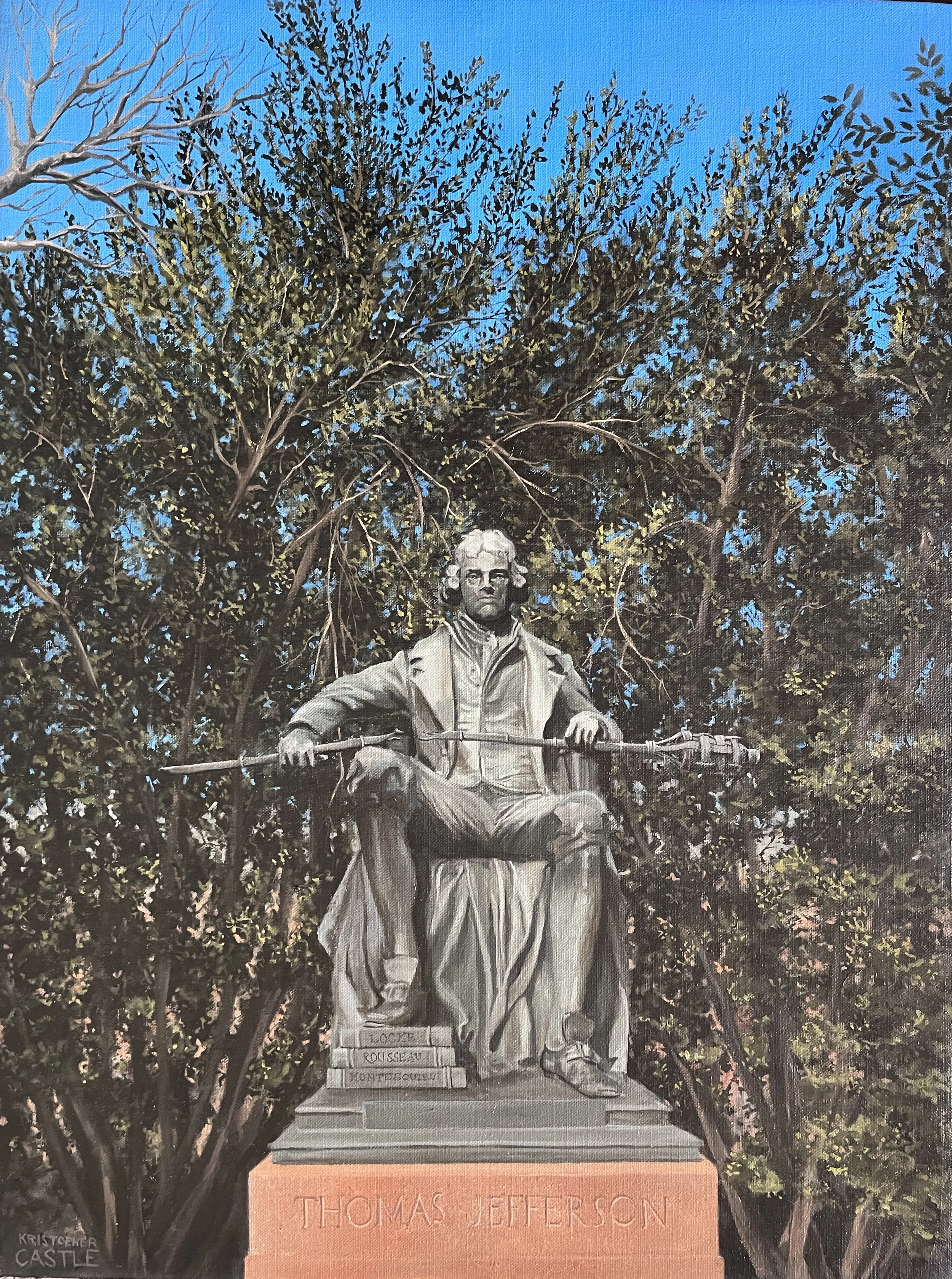
Ab eo libertas a quo spiritus
The spirit comes from him from whom liberty comes
Walnut oil on Belgian linen, 18 x 24 inches, Sold (private collection)
In the midst of a moment in which statues of the nation’s founders are being removed from public spaces, the artist explores and questions an alternative, if subversive, approach in this painting. He redesigned and reworked this statue to convey modern philosophies and points of view through the action and symbolism of the sculpture itself.
In this painting of the seated statue of Thomas Jefferson (on the west side of the south lawn), he employs his own point of view to speak through Jefferson, and commit his physical form to take a stance against the hateful actions that were perpetrated in his name and in front of this very statue, by far right extremists in 2017. In this narrative, he makes Jefferson, as “father” of the university, side with the brave students who confronted the unruly mob in front of another Jefferson statue on the north side of the rotunda.
In this reimagining, he transformed the appearance and meaning of this statue by portraying Jefferson breaking the potent but ridiculous symbol of the extremists over his knee like an inconsequential twig. His right foot is balanced on three volumes of Enlightenment thinkers (Locke, Rousseau, and Montesquieu) forming the philosophical fulcrum over which he makes the decisive break. The title is the latin motto from Jefferson’s coat of arms. It suggests within this context, that the spirit of the university comes from Jefferson himself and that it is one of open-minded curiosity and the pursuit of freedom through acquired knowledge - the antithesis of the philosophies of hate, willful ignorance, division and fear expressed by those bearing torches.

Exita Acta Probat
The outcome is the test of the act
Walnut oil on Belgian linen, 18 x 24 inches, Sold (private collection)
In this portrait of a statue of George Washington located on the east side of the lawn, the physical form of the statue is repurposed as a rebuff to the efforts of the post-modernists and post-structuralists. These two sequential schools of 20th century philosophy, which pervade American universities today, purport that meaning itself can only be understood through labyrinthine distinctions in language, that all social dynamics should be viewed through a spectrum of oppression and that heroic meta narratives are no longer useful in shaping the future.
In this philosophical revision of the statue, Washington is uncloaking a miniature version of the most lasting visual symbol of his achievements: the Washington Monument, which replaces the column in the original statue. The cloak represents him throwing off the imposition of woke ideology used to subvert his legacy. Three volumes of twentieth century thought: Foucault, Derrida, and Marx, which would celebrate this critical and punitive reevaluation of his efforts, are balanced precariously on the plinth, and Washington is willfully pushing them off with his walking sword.
Washington’s legacy is complicated and flawed to be certain. However, these philosophies would have Washington viewed as only a powerful oppressor, ignoring the fact that twice in his life, as a lesson to his fellow citizens, Washington chose to relinquish nearly absolute power. After the revolutionary war he resigned his post as Continental Commander which came with many of the rights of rule granted to a dictator, and more impressively, he willingly exited the presidency after two terms, setting up the American precedent of the peaceful transition of power.

Inexplicabilis libertas
Illimitable freedom of the human mind or McKim, Meade & Blight
Walnut oil on Belgian linen, 24 x 48 inches, Unavailabe (artist’s private collection)
Integral to Jefferson’s idea for the Academical Village was the open end of the lawn opposite the rotunda, of what would have otherwise been a quadrangle of buildings. This expanse looked out upon the vast Blue Ridge Mountain Range to the south. He considered this vista to be the metaphorical representation of the illimitable freedom of the human mind. He had hoped that as the university grew, it would do so along the same north south axis he’d created with the lawn’s orientation, further developing the east and west sides with interspersed pavilions and student rooms, and leaving the southern end open to the inspirational view beyond. In the late 1890s that changed when McKim, Meade & White were hired to repair the fire-damaged Rotunda. Due to the lack of reverence shown toward Jefferson’s inspirational vista by that generation of administrators, they were also engaged to enclose the end of the south lawn with a group of three buildings evocative of Palladio’s Italian architecture - skewing away from the “Americanised” Palladian vernacular Jefferson had employed in his original iterations on the North Lawn. As a result, the view to the south and all that it represented is no longer visible, negating a large facet of Jefferson’s design philosophy.
In this painting, the artist reimagines the south lawn today with a magically excised Cabell building represented by a mirage or the memory of it lingering in the air, with the full, undeveloped view of the mountains that Jefferson intended visible behind it. In the foreground, is the darkened, nude figure of the artist at twenty one, seen from behind, “streaking the lawn”. This is a long held rite of passage for braver students, which he too experienced in 2001 - representing his own physical embodiment of that same illimitable freedom.
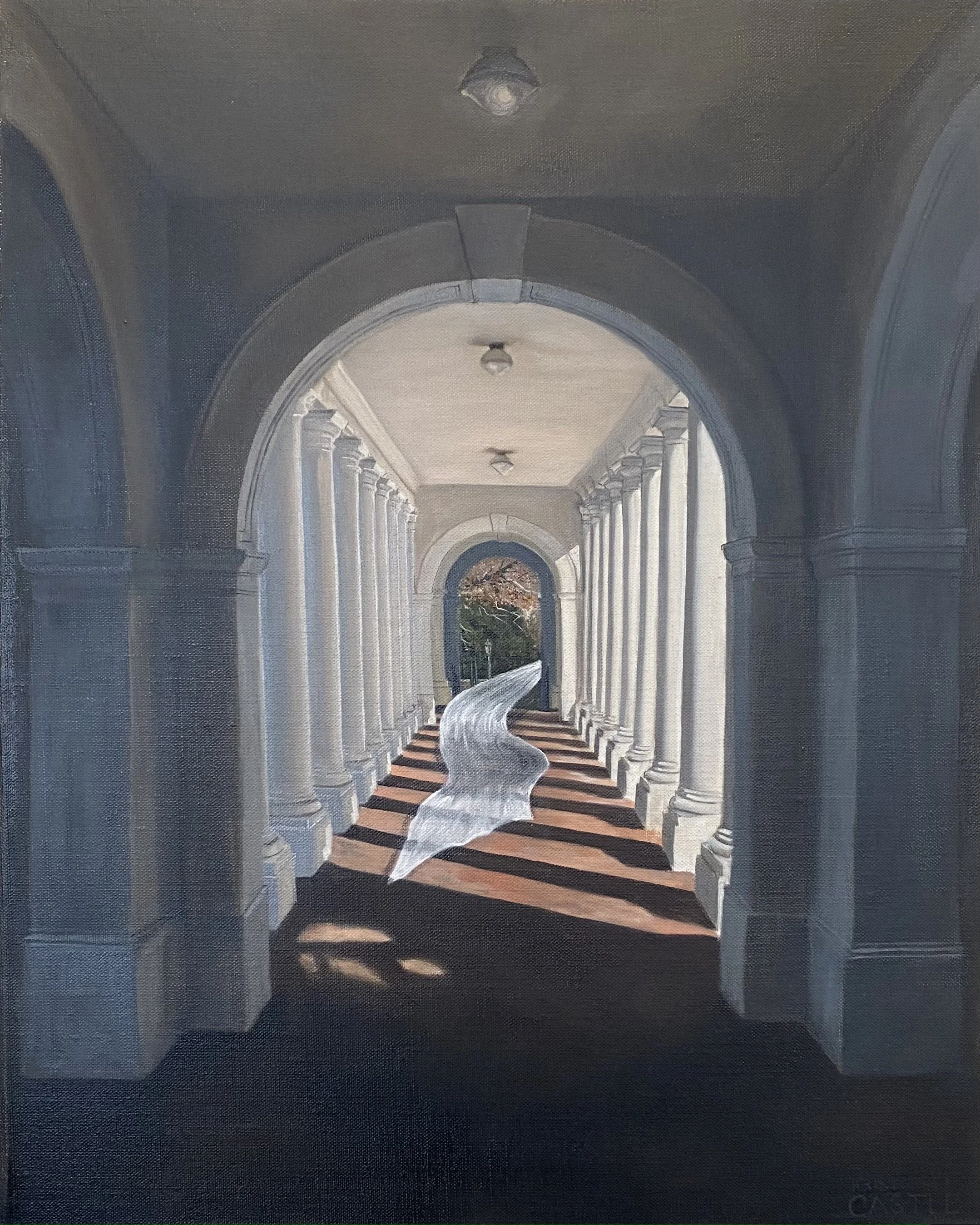
Initius
Commencement
Walnut oil on Belgian linen, 16 x 20 inches, Sold (private collection)
In this final quiet architectural painting of a colonnade beside the Rotunda, the same fabric from the first painting of Lambeth colonnade, is seen fluttering through the open door out into the space beyond, as the columns cast long shadows across the ground. This signifies both the temporal nature of youthful matriculation, and of the artist’s own revisiting of the university twenty one years after his introduction to it, through this exploration of its philosophical origins and current manifestations, in paint.
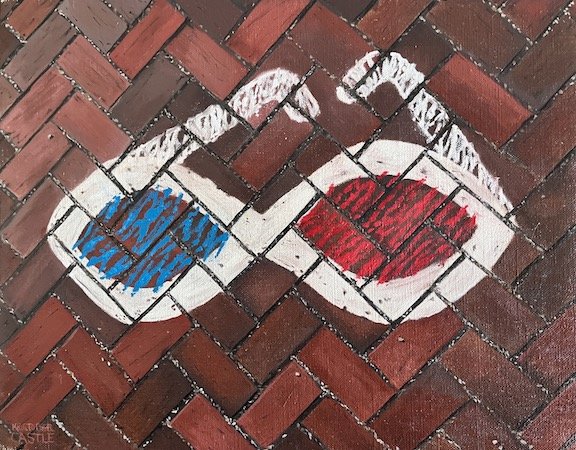
Infinity in 3D
Walnut oil on Belgian linen, 11 x 14 inches, Available
This painting plays with the infinity symbol that tops the emblem of the 7’s secret society, found on the front steps of the university, leading to the Rotunda. Using the idea of sidewalk chalk as a medium (though rendered in oils) the artist turned the symbol into a pair of 3D glasses encouraging the viewer to see this small trio of paintings through a more whimsical lens.
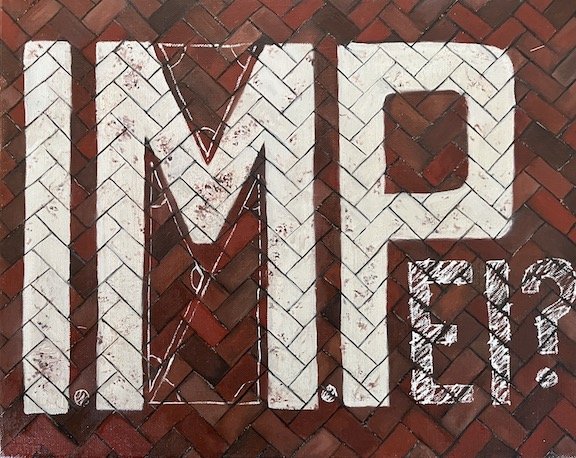
I.M. Pei?
Walnut oil on Belgian linen, 11 x 14 inches, Available
This lighthearted play on the IMP secret society emblem, pokes fun at the architecturally uninitiated who may be leaving a self-guided tour of the Academical Village pondering which American architect was responsible for designing it. The triangles tucked into the interior angles of the letter M are a nod to Pei’s love of the triangle form, and to his own rumored involvement with secret societies.
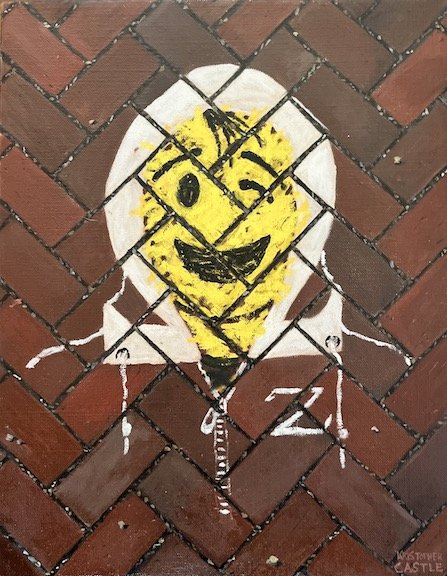
Winky face in a Z’s hoodie
Walnut oil on Belgian linen, 11 x 14 inches, Available
In this second painting of this movement, featuring an element of the 7’s society emblem, the artist turned the Omega symbol contained therein, into a chalk drawing of a hoodie worn by an iconic winking smiley face. On the hoodie is the emblem for the Z’s secret society. This playful disguise worn by a cheeky, iconic form, is a nod to the mysterious nature of the societies (and might someone be a member of both?), while also being a tongue in cheek play on the two final letters of the Greek and Roman alphabets.